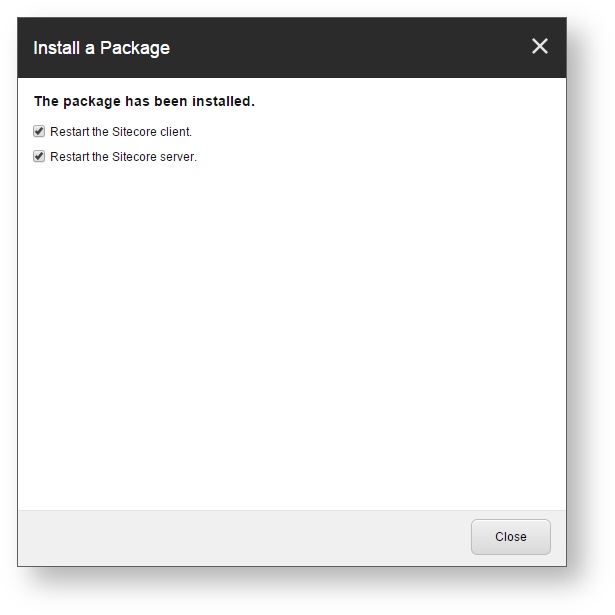Upgrading from May 2018 to August 2018
Upgrading from May 2018 to August 2018
For the best Coveo for Sitecore experience, always follow the Leading Practices When Upgrading Coveo for Sitecore.
This section describes how to upgrade Coveo for Sitecore 4.0 from the May 2018 to the August 2018 release.
Step 1: Upgrade Coveo Services
-
Ensure that you have Coveo Enterprise Search (CES 7.0.9272.3). If necessary, proceed as follows:
-
Install the March 2018 Coveo Enterprise Search 7.0 x64 (9272) for Sitecore.
-
Install the third hotfix for the March 2018 release of Coveo Enterprise Search (CES 7.0.9272.3)
Although you may refer to Upgrading CES for general instructions on how to upgrade CES, you must use the Coveo for Sitecore specific installation files which can be downloaded on the Coveo for Sitecore Downloads page.
-
-
Ensure that you have installed the August 2017 release of the Coveo Search API (8.0.1168).
Step 2: Upgrade Coveo for Sitecore
Ensure that the Microsoft MVC security update MS14-059 is installed on every Sitecore host in your environment.
If you’re using the Coveo Admin Service in secure mode, read this notice before installing the package.
In the Coveo.SearchProvider.config file, make sure that the AdminServiceUri value uses the same host name as the one specified in the certificate. If you’re using a different host name, such as localhost, you might get the error below when installing the package.
The remote certificate is invalid according to the validation procedure.
...
[WebException: The underlying connection was closed: Could not establish trust relationship for the SSL/TLS secure channel.]
...
[SecurityNegotiationException: Could not establish trust relationship for the SSL/TLS secure channel with authority 'localhost'.]
-
Log into the Sitecore Desktop.
-
Access the Installation Wizard (Sitecore Start Menu > Development Tools > Installation Wizard).
-
Install the Coveo for Sitecore .zip package.
-
When prompted to overwrite files, click Yes to all.
-
When prompted to overwrite items, select Overwrite, then click Apply to all.
You might be prompted twice with this question. Select the Overwrite option and click Apply to all both times.
-
Once the installation is completed, make sure that you restart both the Sitecore client and server.

Step 3: Manually Update the Coveo Search Provider Configuration File
Merging Your Modifications into the Configuration Files
Since upgrading Coveo for Sitecore modifies the Coveo Search Provider configuration files (Coveo.SearchProvider.config.example and Coveo.SearchProvider.Custom.config.example) with the latest fixes and enhancements, you need to manually merge these modifications into your current configuration files (Coveo.SearchProvider.config and Coveo.SearchProvider.Custom.config). This method allows you to keep your own customization intact, while still benefiting from the latest enhancements brought in the product. You can use a merge tool such as WinMerge to do that.
Step 1: Upgrade Coveo for Sitecore
Ensure that the Microsoft MVC security update MS14-059 is installed on every Sitecore host in your environment.
-
Log into the Sitecore Desktop.
-
Access the Installation Wizard (Sitecore Start Menu > Development Tools > Installation Wizard).
-
Install the Coveo for Sitecore .zip package.
-
When prompted to overwrite files, click Yes to all.
-
When prompted to overwrite items, select Overwrite, then click Apply to all.
You might be prompted twice with this question. Select the Overwrite option and click Apply to all both times.
-
Once the installation is completed, make sure that you restart both the Sitecore client and server.

Step 2: Manually Update the Coveo Search Provider Configuration File
Merging Your Modifications into the Configuration Files
Since upgrading Coveo for Sitecore modifies the Coveo Search Provider configuration files (Coveo.SearchProvider.config.example and Coveo.SearchProvider.Custom.config.example) with the latest fixes and enhancements, you need to manually merge these modifications into your current configuration files (Coveo.SearchProvider.config and Coveo.SearchProvider.Custom.config). This method allows you to keep your own customization intact, while still benefiting from the latest enhancements brought in the product. You can use a merge tool such as WinMerge to do that.
Coveo.SearchProvider.config
The _id field used to log view events has been changed to permanentid. Therefore, in the externalFields node, add the following externalField:
<field fieldName="permanentid" />
Locate the throttlingAndTimeout/retryStrategy element in the file.
<retryStrategy type="Coveo.Framework.Utils.Rest.ConstantIntervalRetryStrategy">
<numberOfRetry>1000</numberOfRetry>
<interval>00:00:03</interval>
</retryStrategy>
Replace that retryStrategy element with the following:
<retryStrategy type="Coveo.Framework.Utils.Rest.ExponentialBackoffRetryStrategy">
<maximumNumberOfRetries>60</maximumNumberOfRetries>
<maximumWaitTimePerRetry>00:02:00</maximumWaitTimePerRetry>
<timeSlotDuration>00:00:01</timeSlotDuration>
</retryStrategy>
Locate the serverError/retryStrategy element in the file.
<retryStrategy type="Coveo.Framework.Utils.Rest.ConstantIntervalRetryStrategy">
<numberOfRetry>10</numberOfRetry>
<interval>00:00:03</interval>
</retryStrategy>
Replace that retryStrategy element with the following:
<retryStrategy type="Coveo.Framework.Utils.Rest.ExponentialBackoffRetryStrategy">
<maximumNumberOfRetries>5</maximumNumberOfRetries>
<maximumWaitTimePerRetry>00:02:00</maximumWaitTimePerRetry>
<timeSlotDuration>00:00:01</timeSlotDuration>
</retryStrategy>
Coveo.SearchProvider.Rest.config
Locate the retryStrategy element in the file.
<retryStrategy type="Coveo.Framework.Utils.Rest.ConstantIntervalRetryStrategy">
<numberOfRetry>20</numberOfRetry>
<interval>00:00:30</interval>
</retryStrategy>
Replace that retryStrategy element with the following:
<retryStrategy type="Coveo.Framework.Utils.Rest.ExponentialBackoffRetryStrategy">
<maximumNumberOfRetries>10</maximumNumberOfRetries>
<maximumWaitTimePerRetry>00:02:00</maximumWaitTimePerRetry>
<timeSlotDuration>00:00:01</timeSlotDuration>
</retryStrategy>